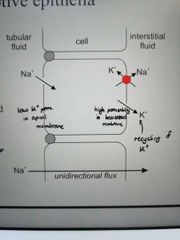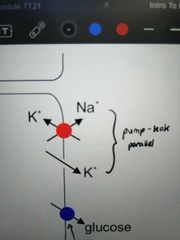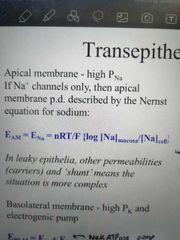![]()
![]()
![]()
Use LEFT and RIGHT arrow keys to navigate between flashcards;
Use UP and DOWN arrow keys to flip the card;
H to show hint;
A reads text to speech;
35 Cards in this Set
- Front
- Back
|
What is the purpose of epithelia? |
To isolate the internal from the external environment, and to regulate the movement of solutes and water to and from the body |
|
|
What are the two functional categories of Epithelia? |
Absorptive and secretory |
|
|
Which ion drives absorptive epithelia? |
Sodium |
|
|
Which ion drives secretory epithelia? |
Chloride |
|
|
Give some common features of all Epithelial cells |
- Sheets of cells that may be multilayered - Separated from neighbouring cells by lateral intercellular spaces - Held together by tight junctions at their luminal edge |
|
|
What is unidirectional/vectorial transport? |
The ability to translocate ions from one side to the other |
|
|
What gives the Epithelial cell the ability to perform unidirectional transport? |
The asymmetry in Channel expression between membranes of the cell |
|
|
Which protein is integral to the transport function of all epithelial cells? |
Na/K ATPase |
|
|
What are the other terms for the apical membrane? |
Luminal, mucosal |
|
|
What are the other terms for the basolateral membrane? |
Contraluminal, serosal |
|
|
What does 'polarised' mean in the context of epithelia? |
That the cells have two asymmetrical membranes, apical vs basolateral |
|
|
Describe the structure of Na/K ATPase |
- 2 subunits, @/B - @ subunit contains a K binding site on EC side, and a Na binding site on IC side - B subunit acts as a wedge to support the protein in the membrane |
|
|
Why is Na/K ATPase considered an electronic pump? |
Because it alters the potential difference of the membrane, by allowing 3Na out for only 2K in |
|
|
What drug can inhibit Na/K ATPase and what class does this drug belong to? |
Ouabain, a cardiac glycoside (like digoxin) |
|
|
What are the functions of tight junctions in epithelia? |
To hold cells together To separate apical and basolateral membranes To reflect solutes and water |
|
|
What are the two types of tight junction in epithelia? |
Tight - prevent any significant movement of molecules between cells Leaky - imperfect seals that allow movement of molecules between cells |
|
|
Where are leaky epithelia often found and why? |
In proximal regions of places like filtration system and GI tract, because they allow bulk flow of isosmotic solutions. They are unregulated and so occur are found before the tight epithelia can exhibit fine control |
|
|
Where are tight epithelia found and why? |
In distal regions of kidney filtration system and GI tract, because they are much more regulated than leaky epithelia and so exert finer control on the exact proportions of solutes that pass through. They can also withstand high osmotic gradients. |
|
|
Which comes first, leaky of tight epithelia? |
Leaky, followed by tight |
|
|
What is transcellular transport? |
Transport through the cells themselves, which depends on active transport processes |
|
|
What is paracellular transport? |
Movement between the cells which relies on passive diffusion |
|
|
Give some important characteristics of tight epithelia |
- complex tight junctions - low paracellular ion permeability - high electrical resistance - high (30mV) transepithelial voltage - low water permeability |
|
|
Give some important characteristics of leaky epithelia? |
- Simple tight junctions - high paracellular ion permeability - low electrical resistance - low (5mV) transepithelial voltage - high water permeability |
|
|
How does sodium enter the apical membrane in tight vs leaky epithelia? |
Through channels in tight, and carriers in leaky |
|
|
How may the low water permeability in tight epithelia be increased? |
Through ADH-induced insertion of aquaporins |
|
|
What is the Ussing model? How does it work? |

The basic mechanism of absorption in epithelia, described by Koefoed-Johnsen and Ussing in 1958 In the basolateral membrane, Na/K ATPase pumps 3 Na out for 2K in. The K is recycled by a K channel, but the Na forms a concentration gradient which is filled by Na entry from the apical membrane |
|
|
How can sodium transport be used to drive absorption of other molecules? |
If the apical sodium entry is coupled to other solute entry, eg glucose via SGLTs |
|
|
Which Na channels are found in tight epithelia? |
ENACs, epthelial Na channels |
|
|
What is the pump-leak model? |

The model that describes how Na/K ATPase pumps 3Na out of the cell in return for 2K in the cell, followed by the leakage of K back out of the cell |
|
|
Which aquaporins are found in tight epithelia? How are these regulated? |
Type 2 - by ADH stimulation, they can be inserted into the membrane to increase water permeability |
|
|
Which aquaporins are found in leaky channels? |
Aquaporins 1 and 3 - these are constitutively active and so are unregulated |
|
|
What is the equation for the transepithelial voltage? |
Ete = Eam + Eblm |
|
|
Assuming only the Na/K ATPase and K channel are present, what is the equation for the basolateral membrane voltage? |
Eblm = Ek + Epump |
|
|
Assuming only Na channels are present in the apical membrane, what is the equation for the apical membrane voltage? |

The nernst equation for Na |
|
|
Describe the process of active Cl- transport in secretion |
Cl- ions enter BLM via NaKCl symporter Cl- exits passively through apical membrane through CFTR K+ recycled back through K channel Na moves passively through cell due to transepithelial voltage Water follows by osmosis |

